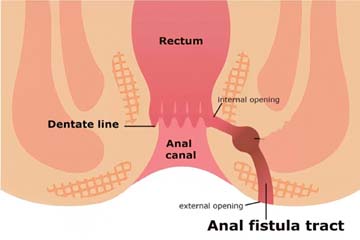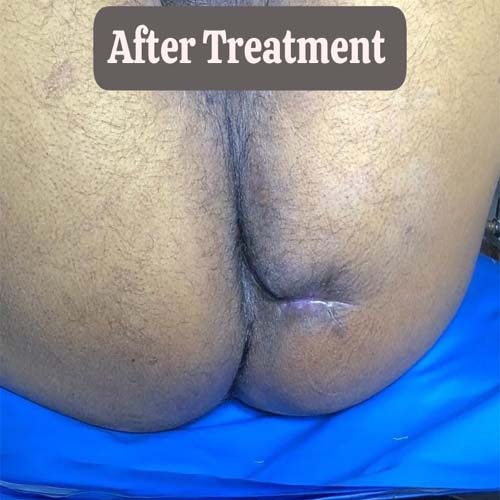
Fistula
A fistula in ano (also called an anal fistula) is an abnormal tunnel or passage that forms between the skin near the anus and the inside of the anal canal. This condition typically occurs after an anal abscess (a painful collection of pus) has formed and then drained, but the tunnel remains, creating a persistent opening.
Causes of Fistula in Ano :
- Infection or abscess :
The most common cause of an anal fistula is an abscess, which is usually caused by infected anal glands. - Chronic Inflammatory Diseases :
Conditions like Crohn's disease or ulcerative colitis can lead to the formation of anal fistulas. - Trauma or injury :
An injury to the anal area or complications from surgery can also result in a fistula. - Poor hygiene :
While not a direct cause, inadequate hygiene can sometimes contribute to infection that may lead to an abscess and subsequently a fistula.
Symptoms of Fistula in Ano :
- Pain :
Especially when sitting or during bowel movements, Swelling or tenderness near the anus. - Recurrent abscesses :
Pus or blood may drain from the fistula opening, Itching or irritation in the anal area. - Foul-smelling discharge :
Due to infection or drainage of pus. - Fever :
If there’s an active infection.
Precautions & Management :
- Early Diagnosis :
If you notice symptoms such as unusual discharge, pain, or swelling in the affected area, seek medical attention. - Avoid Straining :
In cases of anal fistula or gastrointestinal fistulas, avoid constipation or straining to minimize further injury. - Good Hygiene :
Maintain proper hygiene to prevent infections, especially with anal, vaginal, or skin fistulas. - Medical Treatment :
Antibiotics may be needed for infections. Surgical intervention is often required to repair the fistula, particularly if it is complex. - Diet and Nutrition :
For digestive tract fistulas, a proper diet (sometimes a special one) and nutritional support may be necessary. - Follow-Up Care :
Regular follow-ups with a healthcare provider are essential to monitor healing and prevent recurrence, especially after surgery.
What we do at Smilex Advance Laser Piles Hospital :
Our treatment aims to heal fistula, prevents it's recurrence and promote overall well being.
We are specialised in treating complex fistula by IFTAK .
- IFTAK :
Interception of Fistulous tract and application of Ksharsutra, is a minimally invasive surgical technique used to treat complex anal fistulas.,br>IFTAK is effective for treating complex anal fistulas and can help prevent complications and recurrence. The procedure can: Minimize the duration of treatment, Reduce post-procedural pain, Leave minimal scarring, Cause low recurrence, and Cause minimal sphincter damage.
Ksharasutra is made up of natural ingredients.Ksharasutra helps in draining out the infection. Ksharasutra is useful in destruction of the infected anal crypt which is the main reason of the fistula. Kshara sutra gives reactive fibrosis.
This is the only method which is having more than 98 % success even in complex fistula. - FiLaC :
Fistula-tract Laser Closure (FiLaC) is a minimally invasive procedure that uses a laser to treat anal fistulas.
A laser fiber is inserted into the fistula, and laser energy is used to shrink the tissue around the fiber and close the fistula.
FiLaC is a sphincter-preserving procedure that can be used for complex cases. It's considered safe and relatively simple, with a high chance of success. - Laser Fistulectomy :
Laser fistulectomy is a minimally invasive procedure to treat anal fistulas. A small probe is inserted into the fistula tract and guided by an endoscope. Laser energy is then delivered through the probe to destroy the tissues along the fistula tract. Laser fistulectomy is less invasive, less painful, and less expensive than conventional surgery. It's also a sphincter-sparing procedure, so there's a lower risk of damaging the sphincter muscle and resulting in incontinence. - Seton :
A seton procedure is a surgical treatment for a fistula that involves inserting a non-absorbable thread through the fistula to keep it open and allow it to drain. Keeps the fistula open to drain and heal, and avoids cutting the anal sphincter muscles.



